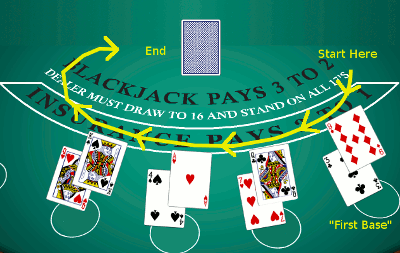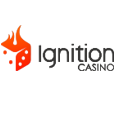Lesson 5 – Card Counting – The Tricks
Last Updated: February 18, 2020No, I’m not going to teach you card tricks here, but I am going to show you a few interesting ways to practice the count you’ve decided to learn and then teach you the methods we use to keep track of the cards as they’re played at the casino. Developing your speed at counting is an important part of your training, because if you can’t count quickly at home, you’ll never keep up with the dealer in a casino. Inaccurate counting can cause you to give up any edge you have over the house and it’s frustrating to constantly “drop” the count when a faster dealer comes along.
At this point you should have the point values of each card memorized and you might be doing some single-card countdowns of a deck. I’m sure you’re slow at it, but that’s OK, since accuracy is the most important factor right now. Speed will come as you work your way through the exercises I’ll show you this week.
Pairs Value Practice
Just as you learned the point value of each card according to the system you wish to use, here you will learn the point value of different PAIRS of cards. This is one of the real “tricks” of the card-counting business: the ability to count cards in pairs. With enough practice, you’ll see a hand of Queen, Jack as both a “20” and an M-2. That capability will bring speed to your game. Here are the values of pairs using the Hi / Lo method of counting:
Hand Net Point Value

 -2
-2

 -2
-2

 -1
-1

 -1
-1

 0
0

 0
0

 +1
+1

 +1
+1

 +2
+2

 +2
+2
Important! Make sure you understand why each pair is valued as shown and don’t forget
that if you’re learning a different count, these pairs may have different values.
If you understand everything above, then start going through a single deck and turn two cards over at a time. DO NOT keep a running count, just recite the value of each pair so you can get used to the adding and subtracting which is required. Do this until you are totally familiar with the values of all possible pairs. Then do it some more.
Laying down a good foundation here will allow you to build your speed quickly later on, so this exercise is time well spent. For you “Type-A’s” out there, you might even push this to learning 3-card values. That is a very helpful skill to have, particularly if you intend to play one-on-one with a dealer, since you always see 3 cards at once; your initial pair and the dealer’s up card. Most of you will want to begin play at tables with other players since things move slower that way, but like I said — knowing the 3-card values won’t hurt.
Pairs Countdown
Once again, remove three random cards from a single deck and set them aside. (No peeking!) Now, turn over the cards two at a time, keep a running (cumulative) count of the deck and check your accuracy by adding the cards you set aside in at the end. This exercise will be your primary way of practicing card counting.
Gradually, your speed will increase to a point where you will count as quickly as you can turn over the cards. To go even faster, hold the deck in your left hand, face up, and pull the cards — two at a time — off the deck with your right hand. (Opposite if you’re left-handed). Help the cards along with your thumb and you’ll start to build some speed. How fast is “fast”? I go through a deck in 10.5 seconds, but all you need to keep up at an average table with 2 or 3 other players is 20 seconds, though 15 is better (and easy attained if you practice).
Counting at the Table
The method we use to count cards at the table is the real secret of this business. For those games where the cards are dealt face up to the players, the diagram below will show you how we do it. Games where the cards are dealt face down (mostly single deck) require a different methodology and we’ll cover that next week.

Most dealers keep their up card face-down until each player has received both cards. The procedure for counting at a table like that is to begin counting when the player at “first base” receives his second card and to count each player’s pair as the cards are dealt. End your count with the dealer’s up card and then count each player’s “hit” cards. Finally, count the dealer’s hole card and any cards the dealer may take as a hit.
You can see that this method of counting by pairs allows you to look more natural at the table. Most people think counters track each card as it’s dealt, so supervisory people at casinos watch for players who follow every cards as it comes out. My method allows you to look away from the table as the first card is going down and then watch as each hand is made with the second card. That looks a lot more natural, since most players are interested in seeing what hands other players get.
Homework
Besides continuing with your basic strategy practice, start playing some “kitchen table” Blackjack. If you can con someone into dealing to you, great, but if you can’t, just deal four player hands out in a manner they use at your favorite casino. Don’t assume the role of the dealer; you want to get used to seeing all this from a player’s perspective so deal one card to an imaginary first-base player, then to yourself and then to two other imaginary players on your left. Finish with a dealer’s card face down across from you and then deal the second player’s card. Begin counting as shown above and finish with a dealer’s up card. Now, play ALL FOUR player’s hands according to proper basic strategy and keep the count. Busy, huh? Don’t worry, with practice it will all come to you. When you’re done with the first round, do another and then riffle through the few remaining cards to verify that you’ve kept the count accurately.
This exercise will form the basis for all of our practice — except speed development — from here on out. As you’ll discover, this type of “overload” makes it very easy to play and keep count at an actual casino game; all you need to do there is just sit back, count and play.




That’s funny. I don’t bother assessing them in pairs, I do them one at a time or possibly several at a time, like more than 2, if that’s the first time I have access to that information like if I was looking away or zoned out or if it’s a face down card and a bunch are overturned. From my perspective, the fastest dealer is practically a glacier. It makes no sense to consider counting them 2 at a time when he ultimately still deals them one at a time, and when after each one, I have plenty of time before he reveals the next one. Ultimately the figure of speech is wrong. The eye is faster than the hand. I have time to watch every tiniest movement of the dealer’s hand effectively in slow motion in comparison to my perception speed, as he slides one card from the shoe and pushes it to 1st base, turns it over to reveal it, and then reaches for the 2nd, and then reaches for the next one to give to 2nd base. By the time he has turned over the 2nd card, the first one is already in my running sum. It really shouldn’t be hard to do this. There’s really no place for looking at them 2 at a time. But even if you don’t see them one at a time, it shouldn’t be much effort to see 4 or 5 at a time and to know the number of low cards minus the number of high cards in that small set, for instance to see a group of 5 cards, see they’re 4 low cards and an 8, and to just add 4 to my running sum. Am I just that fast? Based on getting my ass handed to me in blitz chess matches online, I don’t think my speed is particularly special.
I’m using the Red 7 counting system and have been practicing counting for about a week. I keep losing count about midway through the deck. Does anyone else have this problem? Any help will be appreciated.
Everything published about the Red 7 count got one thing wrong. On a single deck the IRC is -2 and
they say when your finished counting down a deck of cards you should end with a +2. Wrong!!!!!!
The running count should be 0 at the end of the deck not +2. Even Arnold Snyder got it wrong and
he’s the author of the book. Everyone else in these Blackjack forums that publishing stories on the RED 7 system also got it wrong. It seems they blindly write these articles without checking. No wonder I was having a hard time
counting down a deck of cards.
40? You’re definitely not ready
Hey Ken,
No disrespect, but 10 seconds… really? Like 52 cards? I couldn’t even turn over a whole deck in 20 seconds.
I just went through a deck in two’s and then in three’s both in 40 seconds… Am I ready to hit a table?
Yeah, I’ve never agreed with this idea that you have to be super-fast to be successful. The GameMaster and I agree that you need to be accurate and relatively quick. But 40 seconds is quite reasonable in my opinion.
You really should know it’s better to use 2-7 against 9 10 and A instead of 2-6 against 10 and A. Hi-lo may be the original and of historical significance, but it’s better to use 7’s as low cards and 9’s as high cards with only 8 as the one not counting for anything. It’s just as easy a method to do in practice, and it is better for everything except the insurance correlation (the truecount threshold for taking insurance is 4.000 doing it that way instead of 3.333 with hi-low, which is 20% higher, but of course the standard deviation of the count will be sqrt(1.2) times as high, 10% higher, with 1.2 times as many cards having point values).
If you find a place with a super promotion, so that you actually have a slight advantage even flatbetting, you could practice with another vector when the pressure is off and you can stop trying for the rest of the shoe, but the casinos will be most looking for hi-lo first and foremost, and if you are doing something that is not quite the same, yet works better, that means they are less likely to detect you, because you may be betting low when they’re expecting you to be betting high and vice versa, AND you’re more likely to leave the casino a winner instead of a loser.
As such, it is a bad plan to burn this into memory and indoctrinate yourself with the habit of seeing a 7 and an 8 and saying that’s 0 points. No, it’s 1 point. Or seeing a 4 and a 9 and saying that’s 1 point. No, it’s 0. Break that habit before you make it in the first place, don’t train yourself to follow an inferior method as if it was 2nd nature.
Actually, Hi-Lo has a betting correlation (BC) of 0.9682, while your recommendation (AKA the Silver Fox count) has a very slightly lower BC of 0.9625 instead. (See https://www.blackjackinfo.com/card-counting-efficiency-calculator/ or https://qfit.com/card-counting.htm) Yes, the playing efficiency (PE) is improved with Silver Fox, but the Insurance Correlation is far weaker. For beginning players I absolutely stick with my recommendation of either Hi-Lo or KO.
These counts are so similar in practice that you are unlikely to gain much camouflage value by including the 7s and 9s. Yes, I agree that the 7 is effectively a low card, and the 9 effectively a high card, but to weight them the same as the others is iffy. If these kinds of things concern you, use the more complex count that I actually use, Wong’s Halves.
Where should you sit at the table? or does it matter?
For a card counter, there is a tiny advantage to be gained by sitting at “third base”, since you get to see a few more cards before you must play out your hand. But the effect is minimal expect in single deck. I recommend most inexperienced counters not sit at third base, because other players mistakenly think your play makes a difference in their results. Until you develop a pretty thick skin, just avoid that issue by sitting elsewhere at the table.
Hi Ken
I’ve read the KO Blackjack book. I don’t know if it’s because I bought a digital download, but found it a bit confusing. I believe after converting the count for a 6 deck game that I could start with 6 and then the advantage will start when I reach 26. So I would raise my $10 bet to $15 at 26 when the advantage begins (I would go $15 instead of $20 as this is the key count, I think, and the odds are just about even) then go to $20 at 27, $30 at 28, $40 at 29, and my big bet of $50 at 30 or higher. Ken, can you or anyone else who knows the KO system, tell me if this is correct?
Thanks,
Glen
In the classic KO version, in six decks you would start the running count at -20, and you could raise your bets starting at -4.
Yes, the values are strange. Most people add 20 to all of this so they can start at zero instead.
Here are a couple of references that might help:
https://www.blackjackinfo.com/knowledge-base/blackjack-card-counting/key-counts-in-the-k-o-system/
and for REKO:
https://www.qfit.com/rekostrategy.htm
For 6-decks, the normal IRC would be -20.
Thanks Ken,
I looked at the references and they helped a bit. I just want to make sure that the what I wrote above would be accurate as I added 26 so I could start counting at +6. This way I could avoid some negative # counting and avoid playing as much as I could when the count gets in to negative numbers.
Thanks,
Glen
Ah, got it. Yes, adding 26 works as you describe.
Thanks again Ken. This is the best Blackjack site!